What Is Walmart Polaris?
Polaris is Walmart’s search and ranking engine—the brain deciding which products appear for a shopper’s query and in what order.
Think of it as a constantly learning system that blends relevance (does your item match the intent?) with quality and offer signals (will shoppers be happy with price, speed, and service?).
If you want predictable sales on Walmart, you need to speak Polaris’s language.
Why Polaris Matters for Sellers
Simple: visibility drives sales. Even a great product won’t sell if it’s buried on page three. Mastering Polaris gets you higher impressions, better click-through, more add-to-carts, and a stronger organic flywheel that reduces paid dependence over time.
How Polaris Differs from Amazon’s A9/A10
While both reward relevance and performance, Polaris leans hard on structured attributes and offers quality (price, shipping speed, inventory reliability).
Amazon is famously content-heavy; Walmart demands content + attributes + offer excellence to unlock top placement.
Step 1 — Nail Relevance with Smart Keyword & Taxonomy Mapping
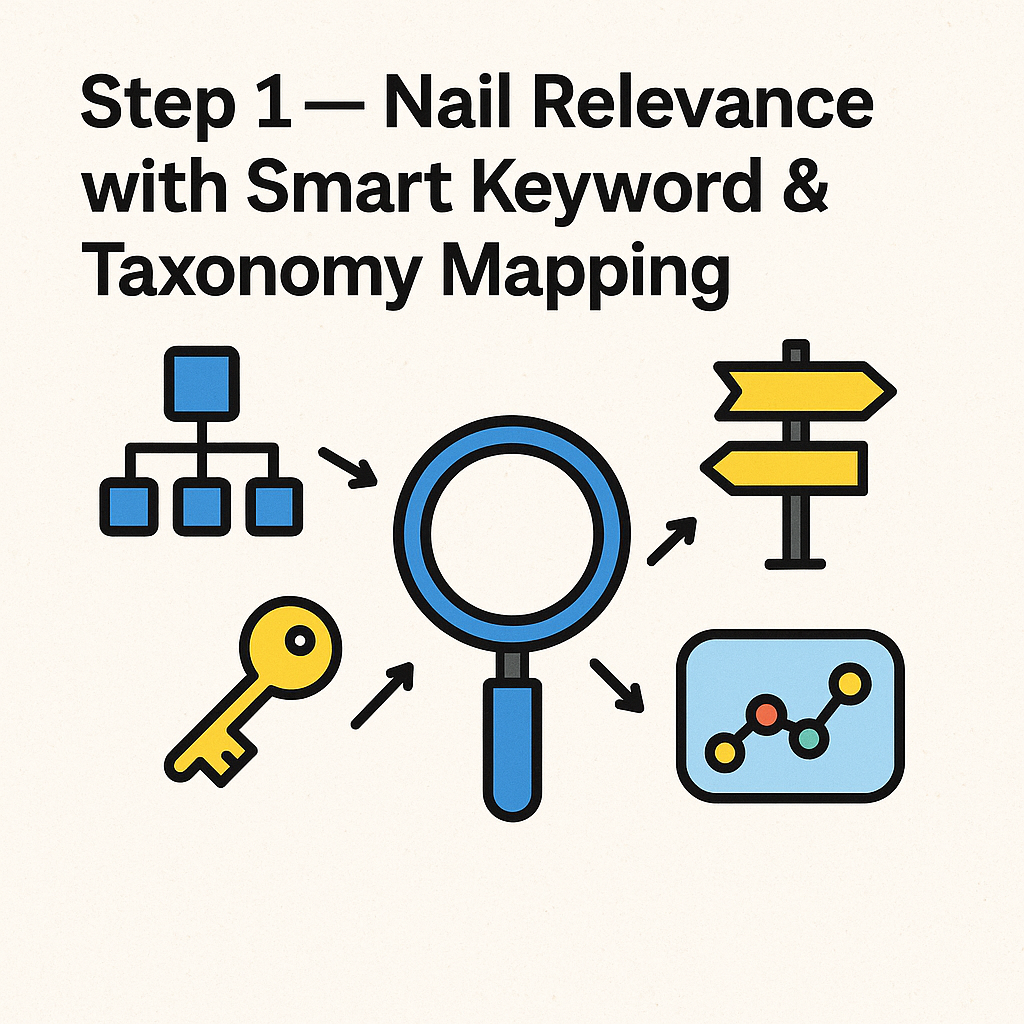
If Polaris can’t “understand” your product, it won’t rank—no matter how good your price is. Start here.
Build a Buyer-Language Keyword Graph
Create a living map of how shoppers search for your product: seed terms, synonyms, attributes, and use-cases. For a “cordless stick vacuum,” include:
- Core: “cordless vacuum,” “stick vacuum,” “wireless vacuum”
- Attributes: “HEPA,” “lightweight,” “pet hair,” “60-minute runtime”
- Problems: “small apartment,” “stairs,” “hardwood floors,” “allergies”
Use these terms strategically—in your title, bullets, description, alt text, and especially in structured attributes.
Map to the Right Category & Item Type
Being in the wrong category is like speaking to Polaris in the wrong dialect. Correct Category and Item Type unlock the right set of required/suggested attributes, increasing your odds of matching queries and filters.
H4: Attribute Coverage: The Silent Ranking Lever
Polaris loves complete, normalized attributes. Fill color, size, material, dimensions, compatible models, age range, scent, wattage—whatever applies. Each filled field becomes a potential match for a shopper’s filter and a stronger relevance signal.
Step 2 — Engineer High-Quality Content that Matches Query Intent
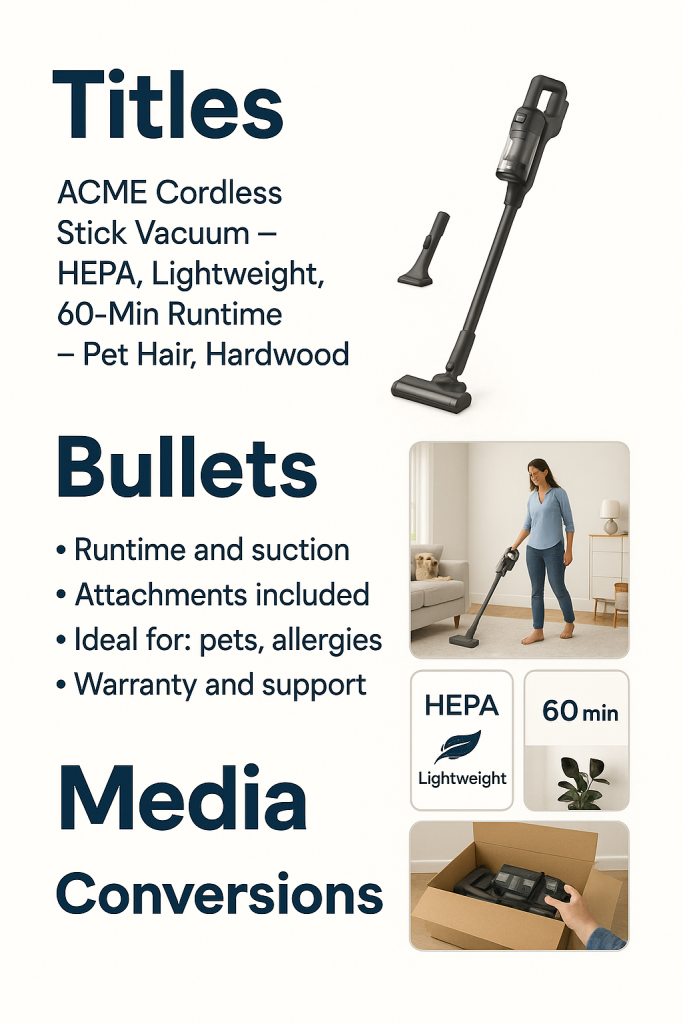
Relevance gets you into the conversation; content earns the click and the conversion.
Titles That Rank and Convert
Craft titles that balance keywords and readability:
- [Brand] [Product] – Key Attribute 1, Attribute 2, Size/Count – Use Case
Example: “ACME Cordless Stick Vacuum – HEPA, Lightweight, 60-Min Runtime – Pet Hair, Hardwood”
Keep it scannable, avoid stuffing, and lead with what matters most to buyers.
Bullet Points & Descriptions that Reduce Bounce
Bullets should answer objections:
- Runtime and suction metrics (with units)
- What’s included (attachments)
- Who it’s for (pets, allergies, small spaces)
- Warranty and support
Descriptions should tell a story. Use short paragraphs, sub-headers, and checklists. Mirror the use-cases and benefits from your keyword graph.
Rich Media (Images/Video/360) and Its Impact on Walmart Polaris
Shoppers don’t read—they skim and look. Include:
- Crisp main image on white
- Lifestyle images that show scale and use
- Infographics that simplify features
- Short demo video (unboxing, setup, results)
Rich media improves CTR, time on page, and conversion, which Polaris reads as quality signals.
Step 3 — Win the Offer Layer: Price, Speed, and Availability
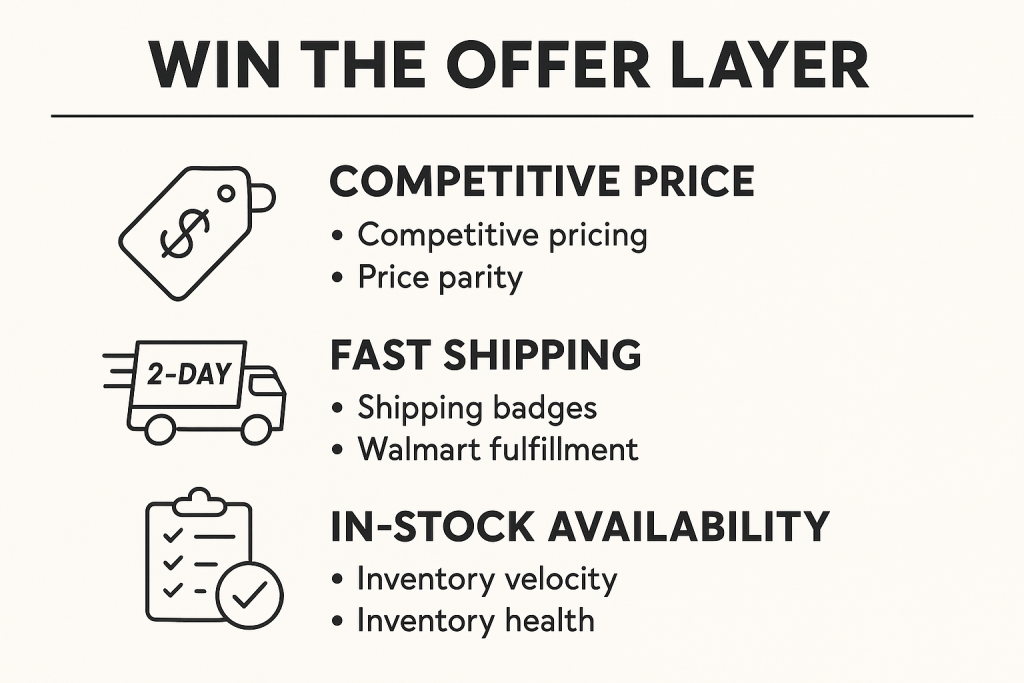
You can’t out-content a bad offer. Walmart’s Polaris will favor items that make shoppers happy after the click.
Competitive Price & Price Parity
Maintain competitive pricing relative to core peers and your own site. Big deviations risk losing buyability and suppressing badges. Use guardrails (min/mid/max) and watch price parity across channels.
Shipping Badges, WFS, and Delivery Promise
Badges like 2-day or NextDay are catnip for CTR. Walmart Fulfillment Services (WFS) boosts delivery speed, reliability, and eligibility for powerful badges, which in turn enhance organic rank.
In-Stock Velocity & Inventory Health
Nothing tanks momentum like stockouts. Track inventory run rate, seasonality, and planned promotions. Keep a buffer during ad pushes to avoid losing rank due to availability gaps.
Step 4 — Build Trust Signals: Reviews, Q&A, and Seller Performance
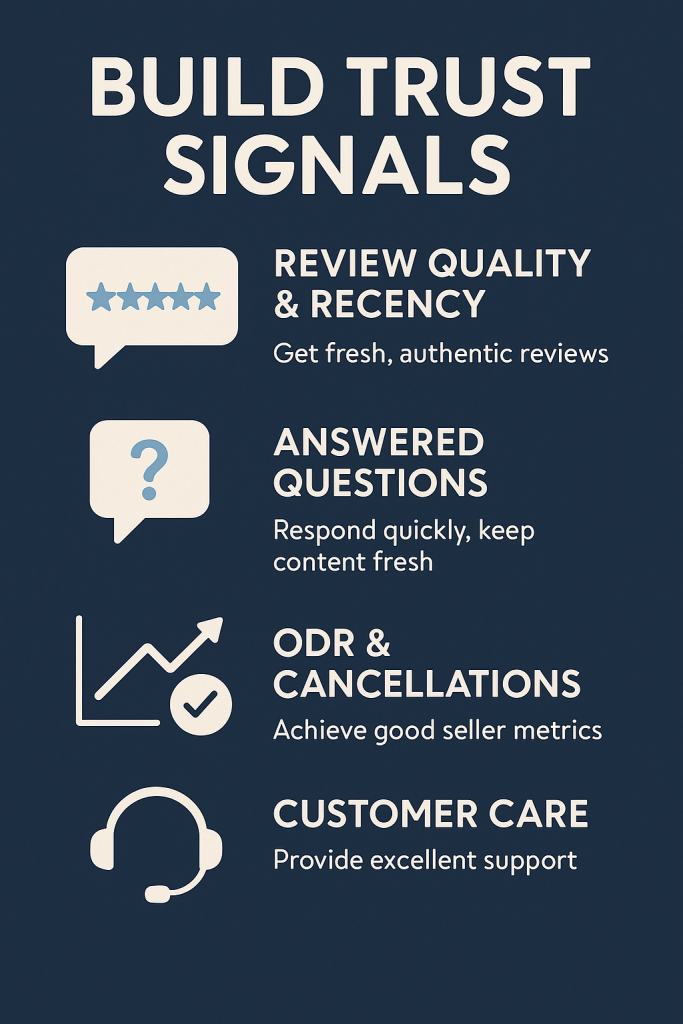
Polaris listens to shoppers. Earn their trust; the algorithm will follow.
Review Quantity, Recency, and Ratings Distribution
Aim for a steady cadence of fresh, authentic reviews. Highlight specific benefits: “quiet,” “great on pet hair,” “easy to clean.” Recency matters—spikes that fade are less helpful than consistent flow.
Answered Questions & Content Freshness
Unanswered Q&A is a leaked conversation. Answer quickly and fold common questions into bullets or an infographic.
Keep content fresh during seasonal shifts and product updates.
ODR, Cancellations, On-Time Delivery & Customer Care
Your Order Defect Rate, cancellation rate, and on-time delivery feed Walmart’s trust layer.
Proactive customer service reduces returns, protects ratings, and sustains rank.
Step 5 — Boost with Ads & Merchandising Without Hurting Organic
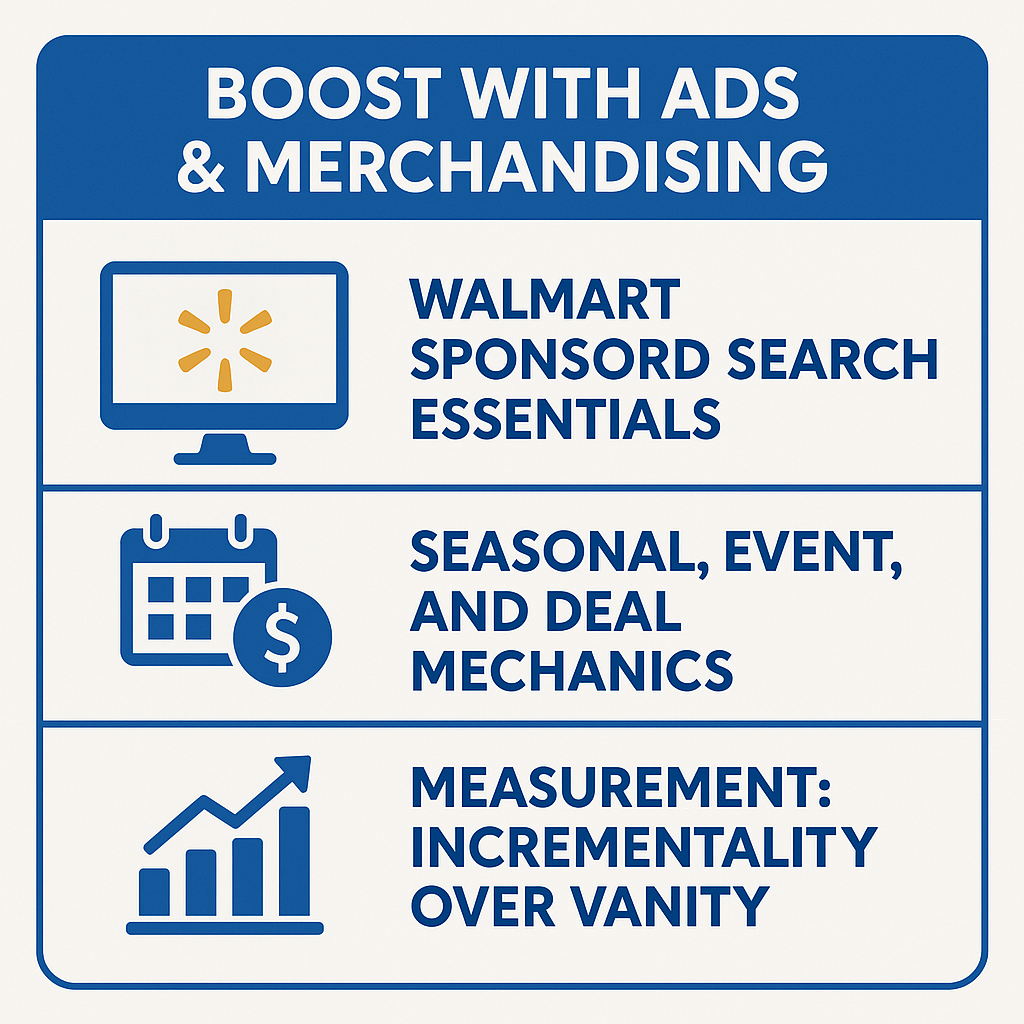
Paid should amplify strong organic foundations—not replace them.
Walmart Sponsored Search Essentials
Start with exact for core money terms, then layer phrases to discover high-intent long-tail.
Keep bids aligned to contribution margin, not just ACOS. Use dayparting to match shopper peaks.
Seasonal, Event, and Deal Mechanics
Tie ads to events (Back-to-School, Black Friday, Spring Cleaning).
Combine with price promos and badges to spike CTR—and convert those spikes into lasting organic gains.
Measurement: Incrementality over Vanity
Look past the impression vanity. Measure incremental sales, blended ROAS, and organic share growth post-campaign. If paid doesn’t lift organic or total contribution, rethink your plan.
Advanced Polaris Tuning
Query Rewrites, Synonyms, and Long-Tail Capture
Polaris expands queries. Seed your content and attributes with natural synonyms and long-tail phrases that reflect real buyer language (“pet dander,” “studio apartment,” “tile floors”).
Attribute Normalization & Variations
Use consistent units (inches vs. cm), standardized colors, and normalized sizes. For variations, ensure parent/child data is clean so shoppers can switch sizes/colors without leaving the PDP.
Structured Data Hygiene & Listing Consistency
Keep brand, MPN, GTIN/UPC, dimensions, and weight consistent everywhere. Inconsistency confuses matching and can suppress visibility.
Diagnostics & Tooling
Rank Tracking & Query Coverage Audits
Track rank for your keyword graph, not just a few trophy terms. Build a Query Coverage % metric (keywords where you rank in the Top 20) and expand it weekly.
Split-Testing Titles & Images
Run controlled tests for title ordering, benefit phrasing, and hero image composition.
Keep a log of hypotheses, changes, and outcomes.
Listing Quality Score & Content Gaps
Use Walmart’s content diagnostics to find missing attributes, weak images, or policy flags.
Close gaps methodically; each fix compounds.
Common Pitfalls to Avoid
Keyword Stuffing & Irrelevant Attributes
Stuffing hurts readability and can trigger suppression. Only include attributes that actually apply. Misleading specs tank reviews.
Price Whiplash and Badge Loss
Frequent price swings can cause badge instability, lowering CTR and rank. Use predictable promo windows and maintain baseline parity.
Thin Content & Duplicate Descriptions
Copy-pasting manufacturer text makes you invisible. Write unique, benefit-led copy tailored to Walmart shoppers.
A 30-Day Action Plan
Week 1 — Audit & Keyword Graph
- Extract current titles, bullets, descriptions, and attributes.
- Build a keyword graph by intent cluster (core, attribute, problem, use-case).
- Verify category & item type; map missing attributes.
Week 2 — Content Rebuild
- Rewrite titles for clarity + keywords.
- Rebuild bullets to answer top objections.
- Add lifestyle images, an infographic, and a 30–60s demo video.
- Normalize units and attribute values.
Week 3 — Offer Optimization
- Set competitive price bands and parity checks.
- Enroll in WFS or improve the delivery promise.
- Forecast inventory vs. planned promos.
Week 4 — Reviews, Ads, and Scale
- Launch a compliant review-generation plan (post-purchase email flows, inserts).
- Roll out Sponsored Search with exact + phrase, protect your brand terms.
- Document wins; templatize for your next 10 SKUs.
KPIs That Actually Predict Growth
Query Coverage %, Attribute Fill %, and Badge Uptime
Your leading indicators. Push these up, and sales usually follow.
Click-Through Rate (CTR) & Add-to-Cart Rate (ATC)
Improve hero image, title clarity, and benefits to lift CTR and ATC—direct signals to Polaris.
Organic vs. Paid Share and Blended ROAS
Watch organic share climb as content, attributes, and offer quality improve. Keep paid efficient and additive.
Polaris for New vs. Established Listings
Cold Start: How to Prime a New SKU
Front-load attributes, ship with top-tier images, launch with reliable delivery and a modest promo, then use ads for initial signal generation.
Mature SKU: Defending Category Share
Refresh media quarterly, rotate seasonal benefits, maintain badge uptime, and guard your top terms with always-on brand protection.
International & Multi-Channel Considerations
Price Parity Across Channels
Large cross-channel price gaps risk suppression or rank loss. Keep a harmonized strategy.
Content Localization & Units of Measure
If you expand, localize spellings, units, and compliance claims. Normalize data so attributes still match shopper filters.
Future-Proofing for Algorithm Changes
Structured Content First
Regardless of tweaks to Polaris, complete, accurate attributes remain a constant edge.
Speed, Trust, and Shopper Delight
Fast delivery, honest pricing, and responsive service create durable ranking momentum.
Conclusion
Polaris rewards what shoppers reward: relevance, clarity, speed, and trust. Master the five steps—keyword & taxonomy mapping, intent-matched content, offer excellence, trust signals, and smart amplification—and you’ll see sustainable gains in rank and revenue.
Treat this as an operating system, not a one-off project. Build your keyword graph, normalize attributes, fortify your offer, and measure what matters.
Do this consistently, and Polaris will consistently favor you.
FAQs
Q1: How long does it take to see ranking improvements on Walmart?
Typically, 2–6 weeks after major content/attribute and offer changes, with faster movement if you also stabilize price and delivery badges.
Q2: Do I need Walmart Fulfillment Services (WFS) to rank well?
Not strictly, but WFS often improves delivery promise, badge eligibility, and conversion—all strong indirect ranking signals.
Q3: What’s more important: keywords in the title or attributes?
Both. Titles drive CTR and immediate relevance; attributes power query matching and filters. Treat them as complementary.
Q4: How many images should a PDP have to compete?
Aim for 6–8: hero on white, 2–3 lifestyle, 1–2 infographics, and a short demo video if possible.
Q5: What’s the best way to maintain rankings over time?
Keep attributes complete, refresh media quarterly, protect price parity, maintain delivery badges, and monitor reviews/Q&A for continuous content updates.
